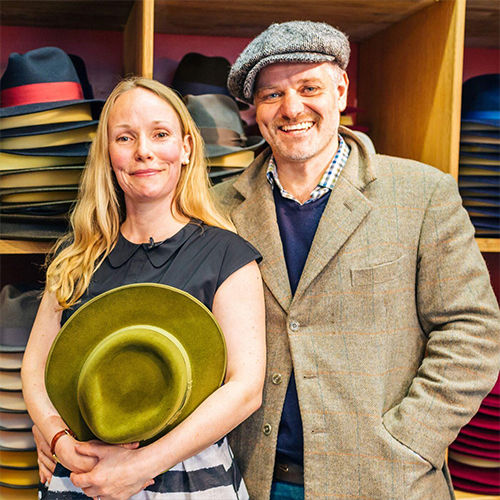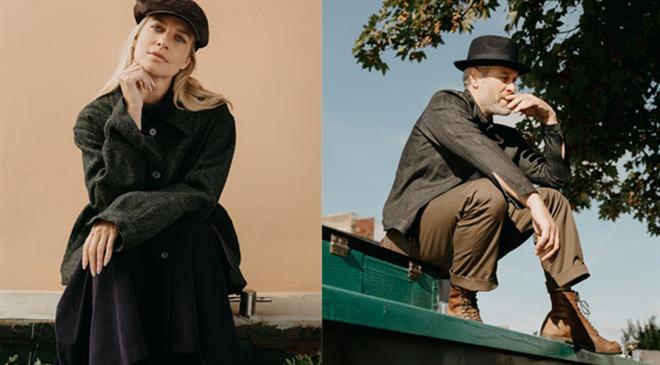
Alex and Zofia Torun-Shaw
Founders
Brand - Laird Utility
Our brand ties in perfectly to our ethic in terms of sustainability and durability
Founded by husband-and-wife duo Alex and Zofia Torun-Shaw, Laird Utility was born out of Laird Hatters, a firm celebrity favourite for high-quality flat caps, trilby and Fedora hats using their favourite British cloth suppliers. The brand’s ethos is built on long-lasting garments for today’s men and women, whilst being produced in the most sustainable way. In an Interview with Fibre2Fashion, the designers talk about the journey of their brand, its aesthetics and signature style, and share wardrobe maintenance tips.
Fibre2Fashion: How would you two illustrate your journey in the world of fashion and what motivated you to launch your brand?
Alex and Zofia Torun-Shaw:
It originated with our hat and cap range and our original brand Laird Hatters. We had long wanted to do a fashion brand because our Laird Hatters brand was born from the vintage movement in the late 00s (2008,2009,2010). We knew we had designs which people wanted to wear. We are heavily into workwear, and it was a natural progression. We had British clothmakers we had worked with for years for our caps, and we felt strongly that half of all fashion really is cloth—how it handles, how it moves, what it is made of? We wanted to make durable fashion, so the cloth makers were ideally placed to team up with. We wanted to create slow fashion, made to last pieces, which is the best type of sustainability, when you don’t have to replace something. Also, we are from Hertfordshire, UK-based with stores in London, Cambridge and Oxford. Most of our suppliers are UK based – so we are not shipping things halfway around the world or importing lots of items. That was our conscious decision process behind our sustainable clothing range. This is the best way – we make it locally, we sell it locally within our domestic market and hopefully if we sell a pair of trousers, a jacket, a cap or whatever Laird does, then you may want an additional colour, but what we produce isn’t going to wear out. All our clothes have double-seams, we are meticulous about how we construct our garments, and they are all made by hand.
F2F: As a husband-and-wife duo, how do you strike a balance between your personal and professional life?
AAZT:
It’s a bit of a pickle. Sometimes we do, sometimes we don’t manage to strike a balance. It is wonderful working together because it gives us the family life and the time mix that we want with children and work life. But sometimes it is equally terrible, as there is no switch off, and invariably we go out as a couple on a date and end up talking about work. But somehow, we muddle through, and it works.
F2F: How would you define the aesthetics of your collections?
AAZT:
We always wanted to go, as with the Laird Hatters’ dynamic, we didn’t want to reinvent the wheel. We wanted to take classic style and through colour, cut, cloth – whichever means to make something enduring, classic but also contemporary. Workwear is huge at the moment, as we move away from either 5-day weeks or working from home, everyone has been dressing more casually. Our brand ties in perfectly to our ethic in terms of sustainability and durability, also how we now live and work in a more relaxed, and functional way.
F2F: What is the signature style or niche of your brand and how difficult is that for a designer to stick to a particular niche or signature style?
AAZT:
If you look at the collection as a whole, and each individual item, the construction of each piece is intricate, but the general style is simplistic. Patch pockets are kept to a minimum, not overly fussy, and buttons that will really last. It’s about the form and function primarily. Our trunk jacket is a signature piece; it is classic denim jacket from single piece denim with fewer pockets. It gives it clearer form and line and wears extremely well as a result. And with all clothes, fewer the seams the longer it will last, as it is then down to the cloth’s strength.
F2F: What challenges have you experienced developing a brand with a motive of conscious and sustainable clothing?
AAZT:
We haven’t had many negatives along the way. As we make by hand in small batches, we can be really adaptable and agile as a business and designer. All the time we are on the lookout for new cloths and there continues to be continual innovations, which is exciting. We see the workwear range expanding and going from strength to strength in the future.
F2F: How do you keep up with the competition? How do you make yourself stand out?
AAZT:
If you worry too much about what others are doing, it will drive you nuts. We don’t look around at competitors. The biggest modern difficulty is bringing your product to market; for every brand it is both easier through social media and being able to get your brand out, but also harder to stand out in a crowded market. We have a large loyal customer base from Laird Hatters built up over the years, who are an ideal group to introduce to our Laird Utility clothing. We have that conversation with our customers, which as a smaller brand we can do easily. Larger brands struggle to have that more personal relationship with customers, while we can do quite well.
F2F: What advice would you like to share with fashion aspirants trying to develop or maintain a capsule collection?
AAZT:
Make it wearable! Many student fashions have eye-catching but outlandish creations that the majority of people would never dream of buying. It may be the start of an inspirational trend picked up in the fashion press for a moment, but never forget: Being commercial isn’t a sell-out, it means you know your clients’ demands and it is longevity for a brand.

Bill D’Arienzo
Aseem Prakash
Fanny Vermandel
Gabi Seligsohn
Abhay Gupta
Anurag Batra
Arun Sirdeshmukh
Rahul Mehta
Pradip Mehta
Rahul Mehta

20230103183907.png)









_8.JPG)

